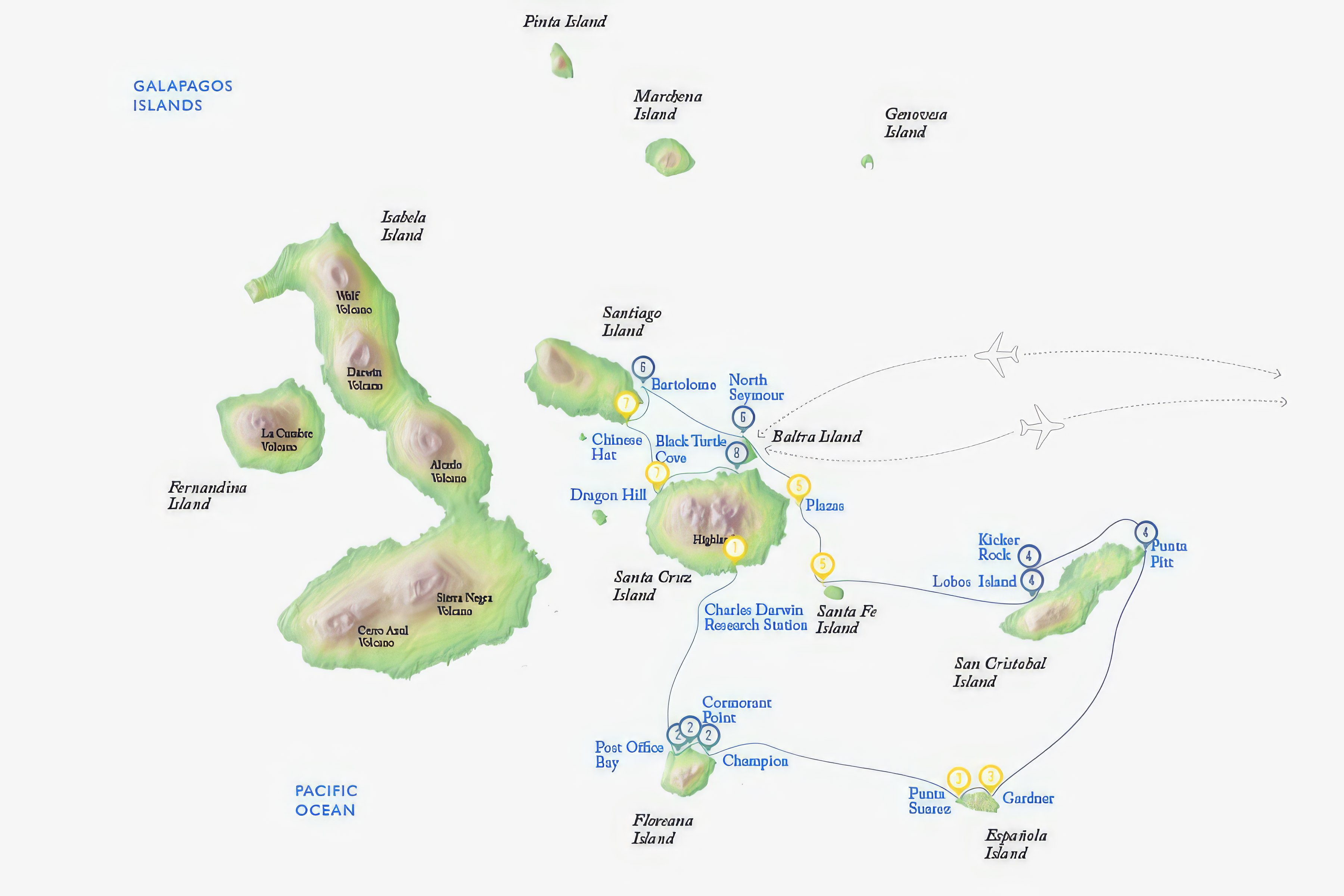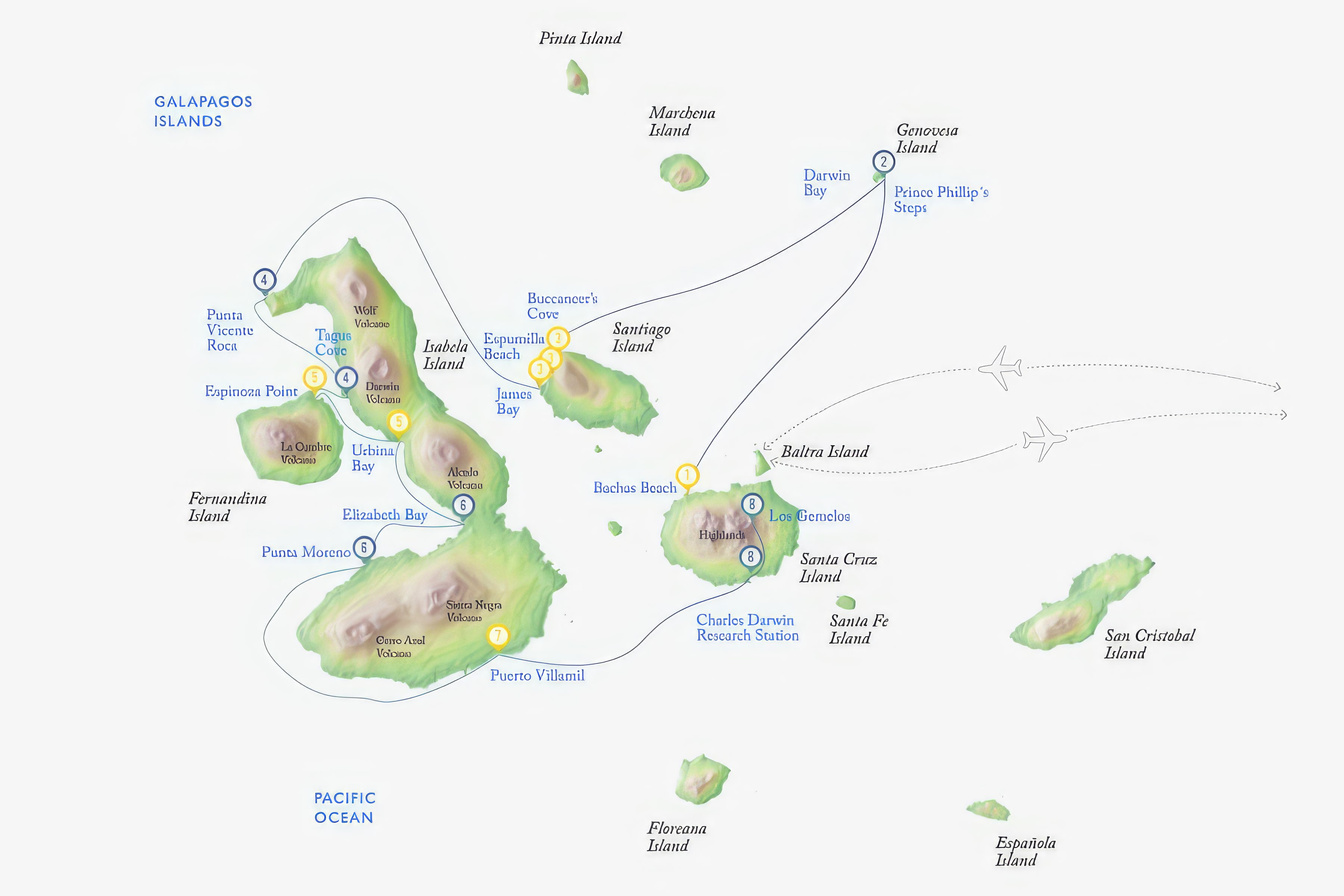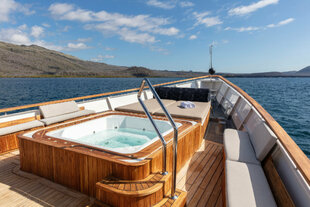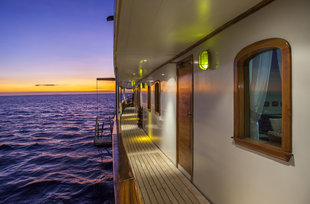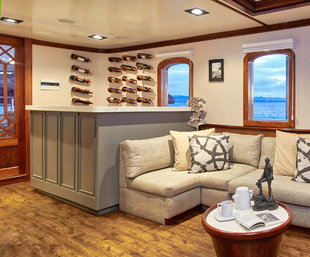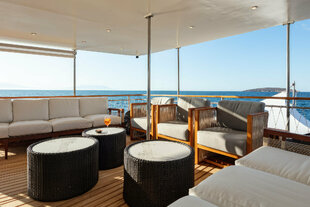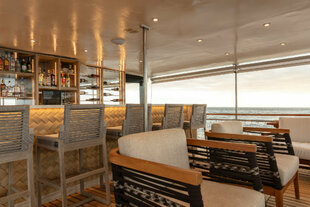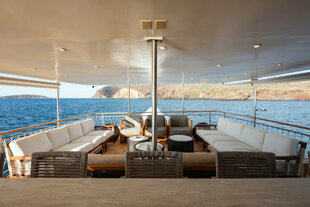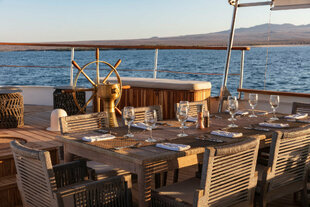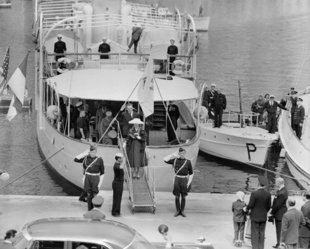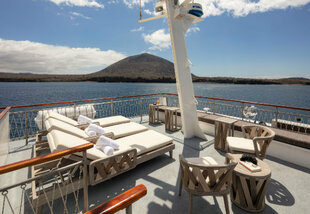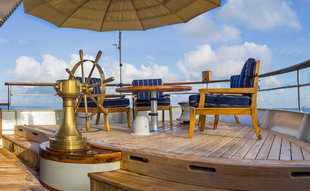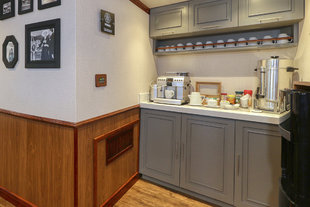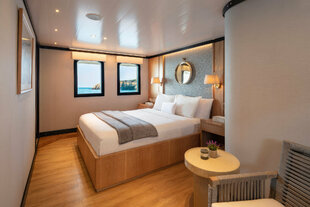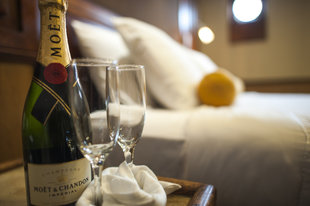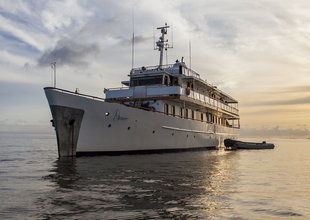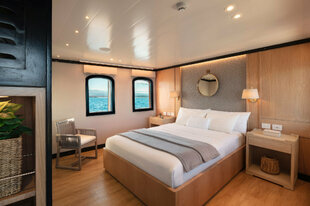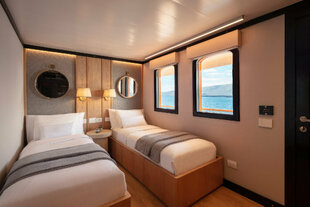Princess Grace is a stunning motor yacht that was once owned by Her Serene Highness Princess Grace of Monaco. In her current representation she maintains all of her elegance, beauty and prestige. Princess Grace is the ideal yacht for the traveller who seeks a safari experience, complimented by excellent service, superb accommodations and excellent dining. She also has one of the best expert naturalist guide to guest ratios of any Galapagos yacht at 1:9.
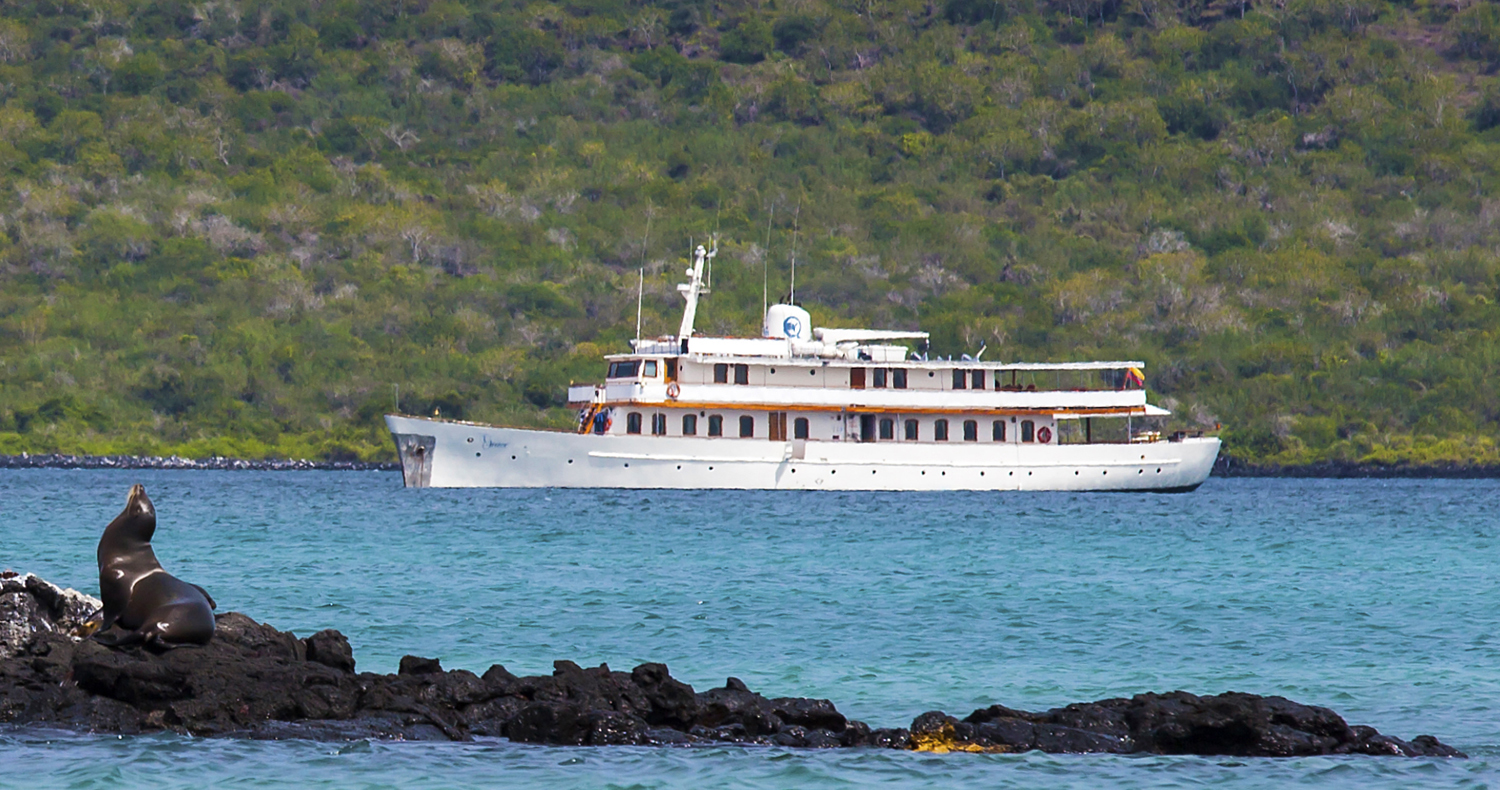
Princess Grace can accommodate up to 16 guests within her 9 luxurious staterooms. All cabins are equipped with air conditioning, private ensuite facilities, telephone, safety deposit box and ample storage space.
Guests can enjoy delicious meals either in the comfort of the interior dining room or in the al fresco dining area. The main salon is a great place to relax and socialise, complete with a TV / Video system and stereo system. Alternatively, guests can soak up the atmosphere and marvel at the beauty of the Galapagos from the spacious sundeck or in the jacuzzi. There is also an outside bar, which makes for a great vantage point for spotting local wildlife.
Princess Grace is also equipped with sea kayaks, a great way to explore the cliffs, shores and hidden coves of the various islands. Snorkelling gear and wetsuits are available for those keen to get even closer to nature and explore the fantastic marine life of one of the world's largest marine reserves.
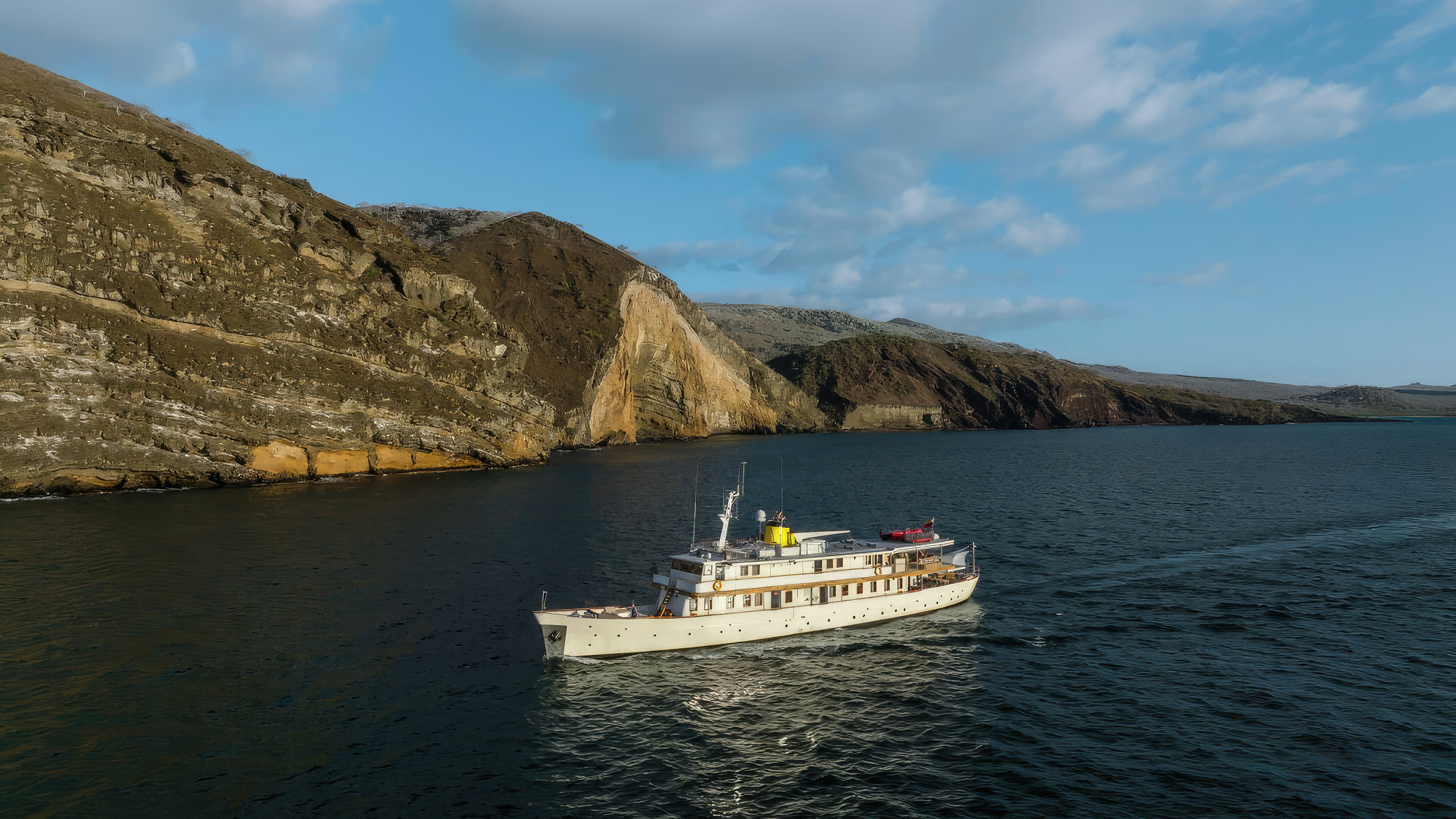
Wildlife & Photography
The main focus of this trip is to experience the Galapagos’ unique wildlife and landscapes above, on and below the water. All itineraries include activities like hiking, kayaking, snorkelling, panga rides and swimming on excursions which take place twice daily, helping to give you the opportunity to explore the archipelago from different perspectives.
Each of the islands provides its own individual environment due to their age differences and stages of colonisation, which can differ by millions of years. As you make your way through any of the itineraries here, you will notice gradual changes in the landscapes and wildlife which you are surrounded by. Some of the wildlife which you can hope to see here includes Galapagos Sea Lions, Marine and Land Iguanas, Nazca and Blue-Footed Boobies, Galapagos Tortoises, Galapagos Penguins and Flightless Cormorants, among many others.
The great abundance and variety of life here makes this trip ideal for photographers. There are plenty of opportunities for every photographer to get their shots – macros of sunbathing Marine Iguanas, wide-angles of Sea Lion colonies and the islands and underwater captures of Sharks and Rays are just some of the possibilities here.
Even though the trips offered here explore a lot of the archipelago’s wonders, there are many other ways which you can explore the Galapagos Islands. If you wanted to extend your stay here to experience more of this location, you could book an add-on experience, such as a dive liveaboard from our Galapagos Dive Liveaboards page or one from our Galapagos page. We also offer trips in mainland Ecuador which you could choose to experience too.
Technical Specifications
| Type | Motor yacht / expeditions vessel |
| Length | 145 ft / 44 m |
| Beam | 22.1 ft / 7 m |
| Engines | 8-cylinder Twin Deutz 500 HP |
| Generators | 2 × Caterpillar 75W |
| Builder | Camper & Nicholson, Southampton, England |
| Cruising speed | 10-12 knots |
| Accommodation | Grace Kelly Suite on Monaco deck 2 × Master Suites on Albert deck 2 × Twin / Queen Suites on Albert deck 2 × Double Premium Staterooms on Carolina deck 2 × Twin / Queen Premium Staterooms on Carolina Deck |
| Crew | 9 + 2 guides & 1 cruise director |
| Dinghies | 2 × 12-person |
| Navigation equipment | 72-mile Furuno radar 19-53 CBB Navnet Furuno GPS satellite navigator system Furuno depth sounder Simrad HS50 electronic gyrocompass Speed & distance log Compasses & barometers Forward-looking echo sounder |
| Safety equipment | EPIRB 2 × 16-person life rafts Life jackets, flares & signals Fire extinguishing & sprinkler system |
| Comfort equipment | Air renewal system Air conditioning TV / CD / VHS / DVD Boutique Hot tub |
| Communications equipment | UHF, VHF radio & satellite phones |
| Electricity | 110V AC 60Hz |
Deck Plan
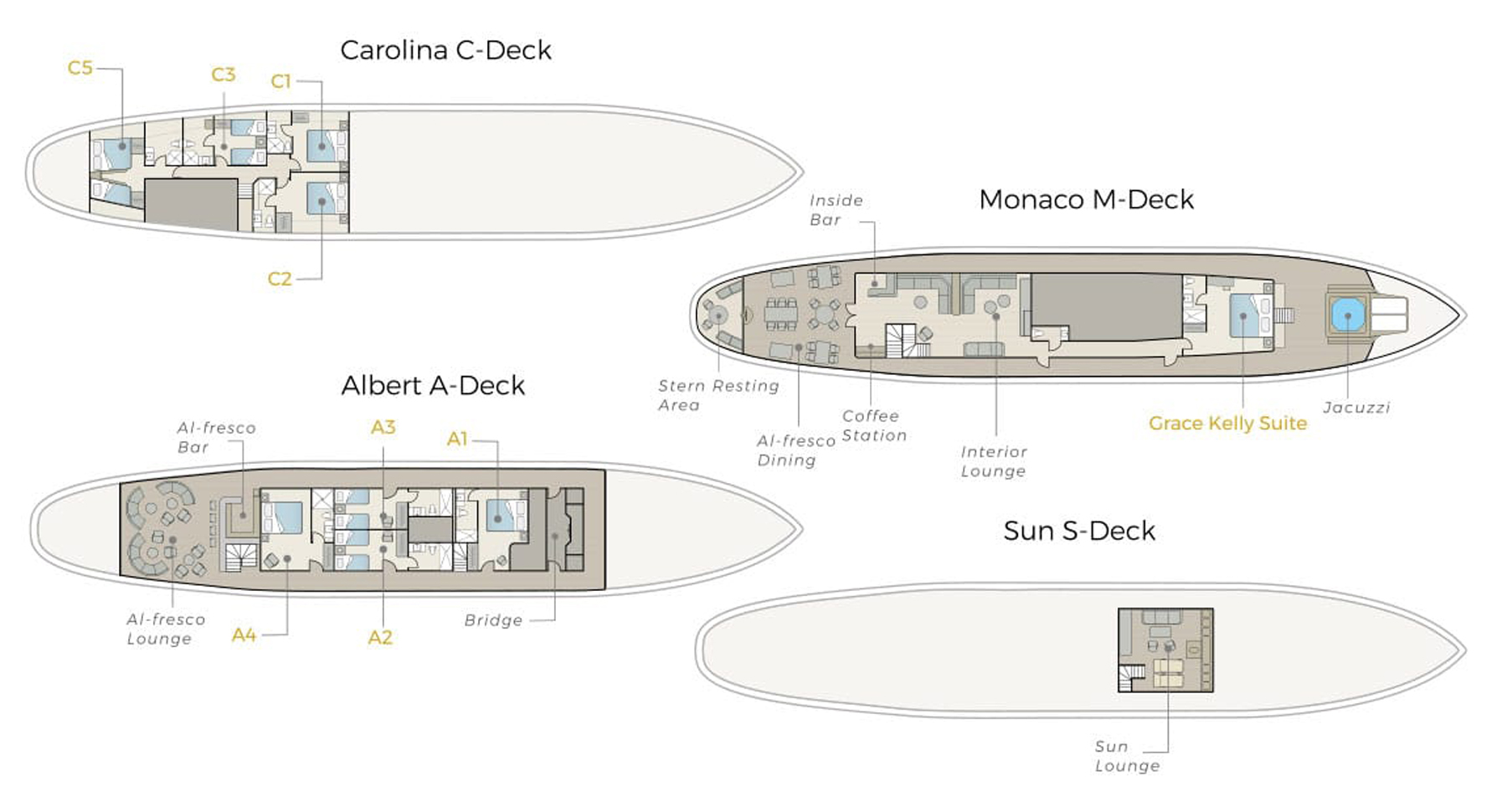
Itinerary
Each itinerary is designed as just a single part of your Galapagos experience and are combinable. We recommend combining itineraries for a more comprehensive visit to the Galapagos Islands.
Please note that these itineraries are subject to change without notice due to seasonal changes, last minute weather conditions and the decision of the Galapagos National Park authority.
Day 1 (Tuesday) – Arrival / Ayora Port & Santa Cruz Highlands / Darwin Station
AM: Arrival, Baltra Island & Puerto Ayora, Santa Cruz
Upon arrival Baltra, travellers pass through an airport inspection point to make sure that no foreign plants or animals are introduced to the islands, and to pay the park entrance fee of $200 (unless it has been prepaid). A guide will meet you, help you collect your luggage and escort you on a short bus ride to the harbour.
Puerto Ayora is a town in the south of Santa Cruz Island and is the largest and most developed in the entire peninsula. There are countless opportunities for food and gift shopping here and the town is even home to the Charles Darwin Foundation and the Galapagos National Park. Tortuga Bay is easily accessible from the town where you can see Marine Iguanas, Galapagos Crabs, White-Tip Reef Sharks and the Galapagos Tortoise. The opportunities in the town make it well worth a visit.
PM: Highlands & Charles Darwin Research Station, Santa Cruz Island
The road to the highlands leaves from Bellavista, a small village located a 15-minute drive from Santa Cruz’ main town of Puerto Ayora. The road passes through the Galapagos’ most productive agricultural zone, up to the National Park boundary. We find Miconia vegetation at this altitude, changing to the Fern and Sedge zone as we ascend further. With clear weather, we can enjoy beautiful scenes of rolling hills and extinct volcanic cones covered with grass and lush greenery all year round. In the Highlands is El Chato Reserve, where Giant Galapagos Tortoises can be observed in the wild – the iconic species which gave the Galapagos Islands their name. Other species to see at this reserve include Short-Eared Owls, Yellow Warblers & Finches. More elusive species which can be difficult to spot here are Galapagos Rails & Paint-Billed Crakes.
Although the great majority of Galapagos visitors come here to observe and appreciate natural wonders, it is also interesting to learn how the protection and conservation of the islands are carried out. The main attractions are the National Park information centre, the Van Staelen Exhibition Hall, the Breeding and Rearing Centre for young tortoises, and adult Galapagos tortoises in captivity.
Day 2 (Wednesday) – Post Office Bay & Cormorant Point / Champion / Devil’s Crown
AM: Post Office Bay, Floreana Island
Post Office Bay is primarily of cultural significance. In times before there was a reliable postal service, a barrel onshore was a point where British 16th century whalers and poachers could post a letter. You are encouraged to write and address one or two post cards; whilst at the same time picking out any which are addressed close to your home, which you are happy to hand deliver when you return.
Shallow waters offshore are lovely to swim in. If you doon a mask and snorkel, you might see Pacific green turtles which often graze here.
PM: Punta Cormorant & Champion Islet or Devil’s Crown, Floreana Island
The peninsula of Punta Cormorant (Cormorant Point) marks the extreme northern cape of Floreana – an island formed from smaller volcanic cones, covered now by tropical dry forest (palo santo). At the landing beach, you are likely to be welcomed by a small colony of Galapagos sealions. The green sand on this beach contains a high percentage of glassy olivine crystals which have been blown out by the surrounding tuff cones.
The ‘flour sand’ beach on the southern side of the peninsula is made up of white coral ground into sand by Parrotfish. It feels very smooth on the feet. You may be able to spot stingrays who use the sandy bottom to bury themselves. During the first months of the year, Pacific green turtles come ashore to dig a nest in which to bury their eggs.
Bottlenose dolphins frequently escort our passage to Champion Islet and you can see them from nearby jumping the bow wave. Underwater, Galapagos sea lions are playful acrobats that become the number one attraction. There are also lots of reef fish, and perhaps a green Pacific turtle. An inflatable dinghy ride along the shoreline of this islet offers sightings of lots of seabirds that are endemic to the archipelago, including Galapagos penguins, blue-footed boobies, magnificent frigate birds and red-billed tropicbirds, swallow-tailed gulls and lava herons. A birdwatcher’s dream is to get a glimpse of the Charles mockingbird on top of Opuntia cacti. This mockingbird is a scientific and historic key species, because it put Darwin on track of his theory of 'adaptive radiation'.
Devil’s Crown is a small outcrop of rocks off the coast of Floreana near Cormorant Point with a circular arrangement which gives them their name. Here, there is spectacular snorkelling with an abundance of reef fish such as Parrotfish, Surgeonfish & King Angelfish as well as Sharks, Manta Rays & Hammerhead Sharks.
Day 3 (Thursday) – Suarez Point & Gardner Bay
AM: Punta Suarez, Española Island
Huge ocean waves crash onto the southern basaltic cliffs of Suarez Point, forming a spectacular blowhole. where the water sprays metres high into the air (depending on the season, the tide and how strongly the sea breeze pushes the waves). This location is home to the only breeding colony of Waved Albatross in the Galapagos. You can also see wildlife such as marine iguanas, Nazca and Blue-Footed Boobies. Take your time for a meditative break in silence at this emblematic viewpoint and convert this unforgettable moment in a lifetime experience.
PM: Gardner Bay, Española Island
The striking white beach at Gardner Bay is an important breeding site for Pacific green turtles. However, without doubt its main attraction is the Galapagos sea lion colony. Females stay year-round in this nursery, suckling their pups up to an age of 3 years, although they start to fish after 5 months of their birth. During the breeding and mating season, the colony becomes even bigger.
Day 4 (Friday) – Pitt Point & Lobos Island / Kicker Rock
AM: Punta Pitt, San Cristobal Island
Pitt Point is a stunning area with olivine beach contrasted against volcanic tuff making it great as a location for experiencing from both land and water. It is a haven for many sea birds which nest along its coastline. It is one of the few places in the Galapagos where you can see all 3 types of Boobies. Even more unique, it is also home to Frigatebirds & a Sea Lion colony.
PM: Lobos Island & Kicker Rock
The beach on Lobos Island harbours a colony of Galapagos sea lions. As in other colonies in the archipelago, you can approach nurturing females within a few metres. In the breeding season this colony is also visited by territorial males, defending and mating the harem on their section of beach. This low islet is home to more than just Galapagos sea lions. Two other emblematic species breed here: male blue-footed boobies and great frigate birds. In season, booby males try to impress females with clumsy dances, showing off how blue (and healthy) their feet are. Male frigatebirds inflate and wobble huge red throat poaches called gulas. Young fluffy offspring cry for food, whilst juveniles try out their wings ready to fly.
Kicker Rock is the remnant of a volcanic tuff cone about a 90-minute boat ride out from San Cristobal Island. Its sheer cliffs rise 150 metres above the sea surface, all around and through a giant split between its two sections. Above water, the rock itself and birdlife are of interest; but best of all you need to snorkel or scuba dive here. Underwater there is rich life on some of the rock walls – great places for fish life and an incredible number of Pacific green turtles. In other parts there are some impressive caverns and swim throughs which you might enjoy in the company of Galapagos sealions.
The variable currents here attract other marine highlights such as Spotted Eagle Rays and schools of Galapagos sharks. This is also one of the best spots to hope to snorkel with hammerhead sharks. They tend to stay about 6 metres or so beneath the surface, so keep a good watch and be prepared to duck dive.
Day 5 (Saturday) – Santa Fé & South Plaza
AM: Santa Fé Island
Located in the southeastern part of the Galapagos, this island was formed from an uplift rather than being from a volcanic origin, which is why it is mostly flat. There are some theories claiming that this could be the oldest island in the archipelago. Santa Fé is home to a number of endemic species like the Galapagos Hawk, Galapagos snake, Galapagos mockingbird, rice rats and one of the two species of land iguanas on the islands. After disembarking into the beautiful and clear waters, you will be in contact with one of the many sea lion colonies. Along the trail, many saltbushes can be seen, as well some particularly impressive giant Opuntia cacti ‘trees’.
The island is some 24 km2 in area and a maximum 60 metres above sea level. The waters which surround it can be a lovely turquoise blue, with a protective barrier of rocks creating a semi-lagoon which is ideal for humans and sealions alike for swimming and snorkelling.
PM: South Plaza Island
South Plaza is a beautiful island formed out of lava which bubbled up to the sea surface. It is relatively small but very diverse in its botany and very good for spotting Land Iguanas. hybrid Iguanas exist here, created through the mating of male marine iguanas and female land iguanas.
There are approximately 1,000 Galapagos Sealions on the island and birdlife is plentiful. Cliffs on the western side are nesting sites for Blue-footed and Nazca Boobies, whilst we can find Darwin's Finches amongst the rocks of the eastern side, Lava Gulls and lovely Swallow-tail Gulls. Red-billed Tropicbirds often swoop low overhead, whilst in the sea beneath the western cliffs we can often see schools of fish close to the surface.
This island can be one of the best for photography.
Day 6 (Sunday) – North Seymour & Bartolomé
AM: North Seymour Island
This islet is one of most visited sites in the Galapagos and it is teeming with birdlife. An easy circular path takes you through the archipelago’s most extensive colonies of blue-footed boobies and frigate birds. At the beginning of the breeding season, adult frigatebird-males blow up their vivid red pouches (gulas) to impressive football-sized balloons. This is one of the few spots where you can compare the magnificent and the great frigatebird breeding next to each other.
You are likely to come across several land iguanas on North Seymour and the coast can be a good place to spot Galapagos sealions.
PM: Bartolomé Island
One of the Galapagos’ most iconic locations, the beautiful volcanic islet of Bartolomé is among the youngest islands in the archipelago. On a geological scale Bartolomé was only recently born out of volcanic activity. Although at first sight lifeless, Bartolomé offers some of the wildest landscapes and best panoramas of the entire archipelago. To enjoy the postcard view of the idyllic Pinnacle Bay, you have to climb steps to a viewpoint on top of the island (114m / 375ft). Enter a dramatic world of threatening (though extinguished) nearby spatter cones, craters, and lightweight lava droplets that have been spewed out by fiery fountains. The Summit Trail is also ideal for witnessing how scanty pioneer vegetation such as lava cacti manage to take root on the bare virgin lava fields.
Day 7 (Monday) – Chinese Hat & Dragon Hill
AM: Sombrero Chino
Sombrero Chino, or Chinese Hat, aptly named due to its slowly sloping sides giving the island an appearance resembling that of a Chinese hat, is one of the smallest in the peninsula. The recent formation of the island gives it a unique environment where there are different stages of colonisation by pioneer species at this location compared to others you will have visited. Walking on the island is a great way to experience the island’s wildlife, including Sally Lightfoot Crabs, Marine Iguanas, Galapagos Sea Lions & Lava Lizards. Out of the cracks in dried-up lava, lava cacti are a common sight. The waters of the island are calm & home to White-Tip Reef Sharks, so there is ample opportunity for snorkelling & kayaking here too.
PM: Cerro Dragón, Santa Cruz Island
Dragon Hill is home to the largest wild population of Galapagos Land Iguanas on Santa Cruz thanks to efforts by the Charles Darwin Foundation & the Galapagos Park Service. Supporting this species are Bursera forests which in turn support an array of birdlife. On this island is one of the peninsula’s longest walking trails which will take you to the top of Dragon Hill.
Day 8 (Tuesday) – Black Turtle Cove & Departure
AM: Caleta Tortuga Negra, Santa Cruz Island
Black Turtle Cove offers engineless activities, so you will explore it by dinghy, paddling across the mangrove forested coastline of this stretch of Santa Cruz. There is great wildlife here due to the high levels of protection of this environment such as Sea Turtles, Pelicans & Sharks.
PM: Departure, Baltra Island
Your guide & some crew members will go with you to Baltra where you will board the airport shuttle. Your guide will remain with you through the check-in counters & departure hall.
Day 1 (Tuesday) – Arrival & Bachas Beach
AM: Arrival, Baltra Island
Upon arrival Baltra, travellers pass through an airport inspection point to make sure that no foreign plants or animals are introduced to the islands, and to pay the park entrance fee of $200 (unless it has been prepaid). A guide will meet you, help you collect your luggage and escort you on a short bus ride to the harbour.
PM: Playa las Bachas, Santa Cruz Island
These two small beaches are found to the west of Turtle Cove. Their sand is made of decomposed coral, which makes it white and soft, and a favourite nesting site for sea turtles. Behind one of the beaches there is a small brackish water lagoon, where it is occasionally possible to observe flamingos and other coastal birds, such as black-necked stilts and whimbrels.
The other beach is longer, but it has two old barges that were abandoned during World War II, when USA used Baltra Island as a strategic point from which to protect the Panama Channel. The rocky shoreline can be a great place to photography Sally Lightfoot Crabs.
Day 2 (Wednesday) – Prince Philip’s Steps & Darwin Bay
AM: El Barranco, Genovesa Island
Before landing, you will take an inflatable dinghy-ride along the eastern arm of the caldera. As we approach, the soaring 25m / 80ft high walls become overwhelming. Sometimes, a Galapagos fur seal is resting or a seabird is nesting on one of the ledges at the base. You will then have to hike and overcome the steep stairs from the landing dock to a bush of palo santo shrubs on top. Red-footed boobies gratefully use these scarce nesting places so that they don’t have to nest on the rocky ground. Upon arriving at the edge of the rim, the bushes open up and you can enjoy panoramic views, a sea breeze and the amazing flying skills of countless seabirds. Following the exposed rim, you will first pass a place where we usually encounter a colony of Nazca boobies; and finally reach the extensive storm petrel nesting places. If you are lucky, you can spot the well camouflaged short-eared owl hunting for them on foot!
PM: Darwin Bay, Genovesa Island
Inside the submerged caldera of Genovesa lies Darwin Bay, whose diameter is more than 1.5km (1 mile) and it is almost 200 m (650 ft) deep. The small area will surprise you repeatedly, walking along a coral sand beach, crossing barren lava formations and creeks, passing tidal pools, shrubs and further ahead following the top of some cliffs. With this peaceful surrounding, every species has occupied its own ecological niche (or habitat) without disturbing others. There is great birdlife here with starring species including Red-Footed Boobies, Great Frigatebirds & Laval Gulls. These often share the beach with Galapagos Sea Lions.
Day 3 (Thursday) – Egas Port & Espumilla Beach / Buccaneer’s Cove
AM: Puerto Egas, Santiago Island
Puerto Egas is a black beach located at the west side of Santiago Island. Volcanic tuff deposits formed this special black sand beach and made it the main attraction of the Island. This site is called Puerto Egas because Hector Egas attempted to exploit the salt, which failed because the price of salt on mainland South America was too low to make it a viable export. There is a trail which follows the coastline here for sightings of Marine Iguanas, Galapagos Sea Lions and many sea birds. Land Iguanas were reintroduced to the island as recently as 2019, so look out for these as you walk. At the end of the trail is a small Galapagos Fur Seal colony. If you snorkel from the beach here, you may be able to see Turtles, a range of Fish and Reef Sharks.
PM: Espumilla Beach & Buccaneer’s Cove, Santiago Island
Espumilla Beach is an important breeding site for turtles. It suffered for a period, from feral pigs which dug up turtle nests; but the beach’ natural state has been restored so the turtles return year after year to bury their eggs into the cinnamon-coloured sand dunes. 6 weeks later, during the months of February to August, the eggs hatch.
The beach ridge hides a mangle with two lagoons on the backside. A colony of American flamingos and aquatic birds used to be its main attraction, but after a previous El Niño, strong sedimentation altered the water environment, and now no longer provides their food. Vegetation zones are very close by, providing great scenic contrasts. During the climb up a hill, you will be rewarded with a beautiful view of the transitions from sea to beach and from mangrove to a dry palo santo forest.
At the nearby Buccaneers Cove, you will have the opportunity to snorkel amongst Galapagos marine life.
Day 4 (Friday) – Vicente Roca Point & Tagus Cove
AM: Punta Vicente Roca, Isabela Island
There are great snorkelling opportunities at Vicente Roca Point thanks to upwelling cold-water currents here. Marine life in the area includes various Shark species, Galapagos Penguins, Seahorses & Mola-Mola. Other animals which you can hope to see here are Nazca & Blue-Footed Boobies, Brown Pelicans & Flightless Cormorants.
PM: Tagus Cove, Isabela Island
A tour along the cliffs will give visitors a good chance to see the Galapagos penguin, the flightless cormorant and other seabirds. From the landing dock, it is about a 30-minute hike along the trail up to the top of the cliff from where you can view Darwin Lake, an uplifted lake saltier than the sea. You can also see several volcanoes from this location. Look carefully at the graffiti on the surrounding cliffs of the cove, done by pirates, whalers and buccaneers in past centuries!
Day 5 (Saturday) – Espinosa Point & Urbina Bay
AM: Punta Espinoza, Fernandina Island
Fernandina is the third largest island in the archipelago and has a single visitor site: Punta Espinoza, located at the northeastern tip of the island. Here, marine iguanas conglomerate in larger groups than on any other island. They bask around in the sand, swim near the shore and sometimes block the way at the landing dock. Among the unique species found here, we can find the flightless cormorant.
PM: Urbina Bay, Isabela Island
Urbina Bay is on the west coast of Isabela and has a recently uplifted seabed which has forced corals up above the water’s surface, providing a unique snorkelling experience. There are 2 treks at this bay which offer chances of seeing Galapagos Tortoises & large Land Iguanas amongst other wildlife including Flycatchers, Finches & Mockingbirds.
Day 6 (Sunday) – Elizabeth Bay & Moreno Point
AM: Elizabeth Bay, Isabela Island
This is a marine visitor site, so the excursion has no landing point. Your panga ride starts with a visit to the Marielas islets: home to the largest and most important penguin colony in the Galapagos Islands. The excursion continues into a cove, surrounded by red mangroves, where you can admire their red roots and green leaves. Here, you might be able to observe sea turtles, flightless cormorants, spotted eagle rays, golden cownose rays, brown pelicans and sealions. You might also see Galapagos hawks soaring overhead with schools of pompano and dorado fish swimming down below.
PM: Punta Moreno, Isabela Island
Moreno Point is located on the north coast of Isabela Island between the volcanoes Sierra Negra and Cerro Azul. The trail runs along a solid dry lava flow called Pahoehoe into a complex of lagoons. Its main attraction are birds, which are found around the lakes and mangroves.
Day 7 (Monday) – Las Tintoreras Islets / Sucre’s Cave / Sierra Negra Volcano & Isabela Wetlands
AM: Islote Las Tintoreras & Sucre’s Cave or Sierra Negra Volcano, Isabela Island
Las Tintoreras are small islands which lie just offshore from Puerto Villamil – the small, but main town on Isabela. A visit here can be very rewarding. If Galapagos Penguins are around then they might well be the first life you see as you approach by small boat – standing or lying on bare lava rocks, close to the spreading roots of mangroves. Blue-footed boobies are often seen on the same rocks and amongst bright green mangrove foliage.
As you step ashore, take care as there may be hundreds of small young marine iguanas. As you proceed past impossibly sharp and contorted lava, you will come to lava tunnels where white-tip reef sharks (tintoreras in Spanish) rest in shallow water. Sally Lightfoot crabs can be observed on the cliffs leading down to the water.
Further along, you will come to a lagoon and a beach occupied by bull sealion and his harem. In the lagoon you might see marine life such as a Spotted Eagle Ray in the shallows.
At Sucre’s Cave, you can see great lava formations, caves & tunnels in an endemic forest.
Of volcanic scenery, southern Isabela is home to a volcanic crater second only in scale to Tanzania's Ngorongoro Crater. Volcan Sierra Negra is 6 miles (10 km) across! To reach the closest point of the crater edge involves an overland drive and then a between 45 mins to 1 ½ hour hill walk. On a dry sunny day this can be relatively easy. When cloud comes in and there is rain, we have to pick our way more carefully. The summit can often be seen from the southern coast, but on days when cloud obscures a view, we can trek above this layer for clear views across the crater – if not at first then certainly as we trek east along the crater edge where the climate is drier. When you reach the crater edge, the scale of the landscape is difficult to absorb.
The ultimate aim is to trek along the crater edge to Cerro Chico. This parasitic cone erupted spectacularly in 2005, just when the BBC were filming a series called Islands that Changed the World. Just beneath the surface, the rocks can be very hot, with lava tunnels running in all directions. It is essential to stick to marked trails here, because apparently solid rock can be very thin, with large voids beneath. The stark scenery here is a beautiful mix of shades and contrast between vegetation and bare dried contorted lava. Views from Cerro Chico extend far north to the enormous Elizabeth Bay and Fernandina Island.
PM: Wetlands, Isabela Island
Leading from the Centre to the western beaches of Puerto Villamil is a woodland trail and boardwalk through a series of saline lagoons. This can be a good place to see graceful American flamingos, filtering the saline water for shrimp and algae. They are joined by a handful of species of aquatic and shore birds; as well as marine iguanas as you approach the trail where it meets the sea.
Day 8 (Tuesday) – Twin Craters & Departure
AM: Los Gemelos, Santa Cruz Island
The Twin Craters are 2 large sinkholes formed by the collapse of rock over a lava tube. The fertile volcanic soils here have made the Twin Craters heavily vegetated, in turn supporting lots of birdlife. Common sightings in the area include Vermillion Flycatchers, Short-Eared Owls & the Galapagos Dove.
PM: Departure, Baltra Island
Your guide & some crew members will go with you to Baltra where you will board the airport shuttle. Your guide will remain with you through the check-in counters & departure hall.
Dates
Itinerary A – Beyond Darwin's Footsteps (8 days / 7 nights)
Itinerary B – Following in Darwin's Trail (8 days / 7 nights)
Itinerary A – Beyond Darwin's Footsteps (8 days / 7 nights)
Itinerary B – Following in Darwin's Trail (8 days / 7 nights)
Itinerary A – Beyond Darwin's Footsteps (8 days / 7 nights)
Itinerary B – Following in Darwin's Trail (8 days / 7 nights)
Itinerary A – Beyond Darwin's Footsteps (8 days / 7 nights)
Itinerary B – Following in Darwin's Trail (8 days / 7 nights)
Itinerary A – Beyond Darwin's Footsteps (8 days / 7 nights)
Itinerary B – Following in Darwin's Trail (8 days / 7 nights)
Itinerary A – Beyond Darwin's Footsteps (8 days / 7 nights)
Itinerary B – Following in Darwin's Trail (8 days / 7 nights)
Itinerary A – Beyond Darwin's Footsteps (8 days / 7 nights)
Itinerary B – Following in Darwin's Trail (8 days / 7 nights)
Itinerary A – Beyond Darwin's Footsteps (8 days / 7 nights)
Itinerary B – Following in Darwin's Trail (8 days / 7 nights)
Itinerary A – Beyond Darwin's Footsteps (8 days / 7 nights)
Itinerary A – Beyond Darwin's Footsteps (8 days / 7 nights)
Itinerary B – Following in Darwin's Trail (8 days / 7 nights)
Itinerary A – Beyond Darwin's Footsteps (8 days / 7 nights)
Itinerary A – Beyond Darwin's Footsteps (8 days / 7 nights)
Itinerary B – Following in Darwin's Trail (8 days / 7 nights)
Itinerary A – Beyond Darwin's Footsteps (8 days / 7 nights)
Itinerary B – Following in Darwin's Trail (8 days / 7 nights)
Itinerary A – Beyond Darwin's Footsteps (8 days / 7 nights)
Itinerary B – Following in Darwin's Trail (8 days / 7 nights)
Itinerary A – Beyond Darwin's Footsteps (8 days / 7 nights)
Itinerary B – Following in Darwin's Trail (8 days / 7 nights)
Itinerary A – Beyond Darwin's Footsteps (8 days / 7 nights)
Itinerary B – Following in Darwin's Trail (8 days / 7 nights)
Itinerary A – Beyond Darwin's Footsteps (8 days / 7 nights)
Itinerary B – Following in Darwin's Trail (8 days / 7 nights)
Itinerary A – Beyond Darwin's Footsteps (8 days / 7 nights)
Itinerary B – Following in Darwin's Trail (8 days / 7 nights)
Itinerary A – Beyond Darwin's Footsteps (8 days / 7 nights)
Itinerary B – Following in Darwin's Trail (8 days / 7 nights)
Itinerary A – Beyond Darwin's Footsteps (8 days / 7 nights)
Itinerary B – Following in Darwin's Trail (8 days / 7 nights)
Itinerary A – Beyond Darwin's Footsteps (8 days / 7 nights)
Itinerary B – Following in Darwin's Trail (8 days / 7 nights)
Itinerary A – Beyond Darwin's Footsteps (8 days / 7 nights)
Itinerary B – Following in Darwin's Trail (8 days / 7 nights)
Itinerary A – Beyond Darwin's Footsteps (8 days / 7 nights)
Itinerary B – Following in Darwin's Trail (8 days / 7 nights)
For Christmas & New Years departures, a 100% supplement is applied to the per person rate for both suites and staterooms.
15% discount for children under 15 years old (max 3 child discounts per family & cannot be applied on Christmas & New Years departures).
Our prices include
Daily served meals or buffet offering a wide choice of dishes
Naturalist guides & activities throughout the cruise
All transfers (with rest of group) while in Galapagos
Select wines, local beer, cocktails, spirits, soft drinks, juice, coffee, hot chocolate, water and tea are included throughout the cruise
Lectures and entertainment onboard
Snorkeling equipment (masks, snorkels & fins) and wetsuits (3mm long wetsuit)
Kayaks and equipment
Galapagos National Park entrance fee ($100 USD adults / $50 USD children) *
Galapagos Transit Control Card ($20 USD per person) *
Internet / Wi-Fi connection throughout the cruise (within limited schedule)
A year's membership to the Galapagos Conservation Trust.
(*subject to availability)
Our prices exclude
Flights, accommodations, meals, excursions and transfers other than those included in the itinerary
International air tickets to either Quito or Guayaquil, Ecuador
Gratuities to guides, crew and staff
Extra expenses (communication, laundry, souvenirs, etc.)
Trip insurance and medical evacuation insurance
Personal travel insurance
Premium brands of wines, beer or spirits
Mainland Ecuador arrangements (we'd be delighted to arrange these for you)
Galapagos flights for your requested dates (required to be booked through Aqua-Firma)
Single Supplement
Single travellers can book a suite with a 75% supplement which is applied to the per person rate. For staterooms, a 50% supplement will be applied to the per person rate.

